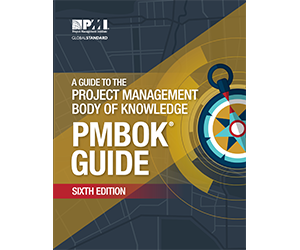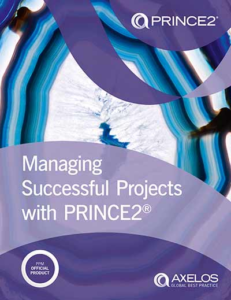
In many areas of life there are multiple ways to accomplish a goal, and project management is no different. At its most basic level, project management is the organization of people to accomplish a task.
Humans have been successfully performing complex projects, like the ancient pyramids of Egypt, for thousands of years however today the processes and methods are codified into methodologies.
There are three official methodologies for project management certification in use today:
- Project Management Body of Knowledge (PMBOK)
- PRINCE2
- International Project Management Association (IPMA)
A fourth, the ISO 21500 standard, is not usually studied and learned directly, and has no certification associated with it. However, it is something of a foundation for all three. The PMBOK is directly derived from it, the IPMA provides a mapping of all processes to it, and PRINCE2 references it.
In this article I will also outline 5 methodologies that are part of project management activities:
- Agile
- Scrum
- Critical Path Method
- Critical Chain Method
- Earned Value Management
ISO 21500 is the foundation of the pyramid, the three official methodologies are the structure, and the five methodologies are the inner workings, the tombs, of the pyramid.
Project Management Body of Knowledge
The pyramids are a great miracle. But the truly great miracle is that the ancient Egyptians did it without the Project Management Body of Knowledge (PMBOK).
The PMBOK is developed and maintained by the Project Management Institute (PMI) in the United States. It is the prominent methodology in use in North America, as well as most of the world except for Europe.
In the PMBOK, projects are divided into 5 Process Groups and 10 Knowledge Areas. The process groups are roughly (but not completely) chronological, whereas the knowledge areas are applied at any time throughout the project. The process groups are horizontal and the knowledge areas are vertical.
The Process Groups are:
- Project Initiating
- Project Planning
- Project Execution
- Project Monitoring & Control
- Project Closing
The knowledge areas are:
- Project Integration Management
- Project Scope Management
- Project Schedule Management
- Project Cost Management
- Project Quality Management
- Project Resource Management
- Project Communications Management
- Project Risk Management
- Project Procurement Management
- Project Stakeholder Management
The Project Management Institute administers the Project Management Professional (PMP) certification, as well as others, which are based on the PMBOK Guide.
In all likelihood, the ancient Egyptians had the Project Management Body of Knowledge, even if it wasn’t called that.
PRINCE2
On par with the PMBOK, PRINCE2 has survived the test of time and would have been used to build the pyramids if it had been developed.
The PRINCE2 methodology is prominent in the UK. It is developed by the UK government and is maintained by Axelos, which is still partially owned by the UK government. Most UK government contracts require PRINCE2 certification in order to bid on them.
In PRINCE2, projects are divided into “management stages,” each of which contain their own task lists, plans and budgets. They can be thought of as project phases.
The method contains 7 principles, 7 processes, and 7 themes.
The 7 principles are guiding philosophies that govern the entire project, and can be consulted at any time, but specifically they are reaffirmed at every management stage boundary. They are:
- Continued Business Justification
- Learn from Experience
- Define Roles and Responsibilities
- Manage by Stages
- Manage by Exception
- Focus on Products
- Tailor to the Environment
The 7 processes represent the physical tasks of project management, and contain various activities and project management “products,” documents that must be produced by the specified member at specified times during the management stages:
- Starting Up a Project
- Initiating a Project
- Directing a Project
- Controlling a Stage
- Managing Product Delivery
- Managing a Stage Boundary
- Closing a Project
Throughout these processes, the PRINCE2 themes apply their valuable knowledge set to the tasks at hand. The themes are similar to Knowledge Areas in the PMBOK, and the seven themes are:
- Business Case
- Organization
- Quality
- Plans
- Risk
- Change
- Progress
PRINCE2’s certification falls into two categories – PRINCE2 Practitioner is the main one and PRINCE2 Foundation is the entry level, associate designation. Both are maintained by Axelos.
International Project Management Association
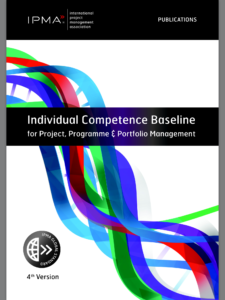 The IPMA, based in Switzerland, has developed and maintained a project management methodology which is prominent in continental Europe.
The IPMA, based in Switzerland, has developed and maintained a project management methodology which is prominent in continental Europe.
The IPMA itself administers the methodology, certification standards, and overall policy. Each country has a membership association (MA) which administers the credential in that country. A few examples of IPMA member associations are:
- United Kingdom: Association for Project Management (APM)
- United States: IPMA-USA
- Nigeria: Project Managers Development Association of Nigeria
The IPMA methodology is comprised on three standards:
- Individual Competence Baseline: The standard for individual project manager competence
- Project Excellence Baseline: The standard for project management
- Organizational Competence Baseline: The standard for organizations that are managing projects
In addition to these three official project management methodologies, five project management methodologies are in prominent use on a practical level, that is, they are used within the methodologies described above. These are Agile, Scrum, Critical Path Method, Critical Chain Method, and Earned Value Management.
Agile
Agile is a project management philosophy that uses iterations, each with its own planning, rather than one master planned project. Agile philosophy dictates that you must deliver working products early and often, which are put in use by the product owner. Hence, the final product is delivered in components.
Decentralized decision making is highly valued and the project manager is a “servant leader” who ensures the team has the tools necessary to deliver the products. The customer / owner is involved directly with the project team on an intimate level, and the project team has the authority to adjust to rapidly changing requirements.
Agile is appropriate in places where significant change is likely, or the configuration of the final product is not well known. For example, software projects (for which agile was developed) and research and development.
Scrum
Scrum is a subset of Agile, but I will include it here since it is prominently used with Agile. In many ways it is a more well defined, practical implementation of the general concepts defined in the Agile Manifesto.
A scrum master is in charge of a project team (scrum team). The scrum team delivers working products to the customer in 1 to 4 week increments, called sprints.
The scrum meeting is a daily meeting which lasts for a maximum of 15 minutes. It occurs in the same place every day. During the scrum, every project team member must explain three things:
- What they accomplished since the last scrum
- What they will accomplish for the next scrum
- What obstacles are in the way
At the end of each sprint, a product is delivered to the customer and a sprint review meeting is held. This sprint review is an opportunity to update the product backlog, which is the priority list of features and improvements for future sprints. Also, a sprint retrospective allows the team to examine what went right, what went wrong, and what processes to improve for the next sprint.
Critical Path Method
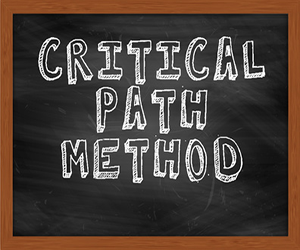 The Critical Path Method has been the cornerstone of traditional project management for many years, and continues to do so today. It is based on identifying the critical path, that is,
The Critical Path Method has been the cornerstone of traditional project management for many years, and continues to do so today. It is based on identifying the critical path, that is,
- Critical Path: The sequence of tasks that determine the completion date of the project.
Tasks that are on the critical path have no float, that is, no room to move without affecting the overall project completion date. Conversely, tasks that are not on the critical path have float, and can finish late without affecting the completion date of the project.
To determine the critical path, the project manager carries out 5 steps:
- Divide the project into tasks
The project is subdivided into its constituent tasks. In project management parlance, this is called a Work Breakdown Structure (WBS). - Estimate the duration of each task
Using standard estimating techniques such as analogous estimating or parametric estimating, the duration of each task is estimated. - Determine the task dependencies
Dependencies such as task prerequisites are identified. Each task should, in theory, be dependent on one other task or it does not need to be a part of the project. - Draw the network diagram
The network diagram allows you to determine the completion date of the project and optimize the project schedule. The tasks that are on the critical path are determined and the task floats of non-critical path tasks are calculated. - Draw the Gantt chart
This is one of the project manager’s most important tools. The graphical bar chart shows all stakeholders very quickly what the project schedule looks like.
Critical Chain Method
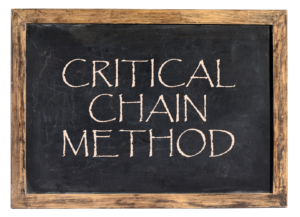
This method is relatively new, having been originally revealed in 1997 by Dr. Eliyahu M. Goldratt.
Dr. Goldratt argued that the critical path method is too mechanical. It assumes that all work fits into neat boxes that get completed at a perfectly uniform rate, as if people were like robots.
In reality, however, people tend to stretch the work into the allotted time. That is, the traditional project management practice of granting the largest possible “contingencies” into each task results in project team members using the extra time even if they don’t need it. In addition, multitasking is the norm on most small and medium sized projects, and this reduces efficiency resulting in a necessary time premium on most project tasks.
To mitigate these human factors, each task duration is estimated at 50% probability and 95% probability. The region between these values is called the buffer. All of the buffers together result in the project buffer.
Managing the buffers is the key to successful project management. Project team members are assigned the smaller (50% probability) task durations. If these are exceeded, the buffer is utilized, but critical project deadlines are not encountered until the entire buffer has been used up. The buffers are used only if they are needed, and maintain a sense of urgency within the project team.
The “critical chain” is the same as the critical path. It is the tasks that determine the completion date of the project. However, the project completion date is communicated to project stakeholders at the 95% level, whereas the task deadlines are communicated to the project team at the 50% level.
Earned Value Management
 Earned value is a project control method, meaning it is used to ensure that the project meets its budget and schedule. It involves the calculation of two groups of variables:
Earned value is a project control method, meaning it is used to ensure that the project meets its budget and schedule. It involves the calculation of two groups of variables:
- Current Project Status. Four variables are calculated that tell the project manager what the current status of the project is:
- Schedule Variance (SV): The current progress measured against the project schedule, expressed as a project budget.
- Schedule Performance Index (SPI): The current progress measured against the project schedule, expressed as a percentage. This is the project’s schedule efficiency.
- Cost Variance (CV): The current budget surplus or shortfall, measured against the anticipated expenditure at the current point in time.
- Cost Performance Index (CPI): The current budget surplus or shortfall, measured as a percentage of the project budget. This is the project’s cost efficiency.
- Project Forecast. Four more variables tell the project manager what to expect from the future performance of the project.
- Estimate to Complete (ETC): The amount of money needed to finish the project.
- Estimate at Completion (EAC): The estimated final project budget/expenditure.
- Variance at Completion (VAC): The estimated final Cost Variance (CV), that is, budget surplus or shortfall, at the completion of the project.
- To Complete Performance Index (TCPI): The required Cost Performance Index (CPI), that is, cost efficiency required to complete the project at its original budget.
Earned value management requires a strong project schedule and budget as a baseline to measure against. If changes occur to the schedule or budget, the earned value variables will all change as well, but this is a common occurrence in most projects.
To use the method, a status interval is chosen, such as one week. At each status point, the variables are calculated and reported to management and/or stakeholders.
Conclusion
Whether you’re building the great pyramids or managing a small project, these project management methodologies are carved in stone and available to be learned and used. Although they may seem like hieroglyphs at times, the building blocks of project management are ready for you to adopt to your project.
